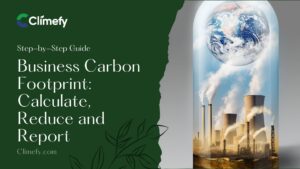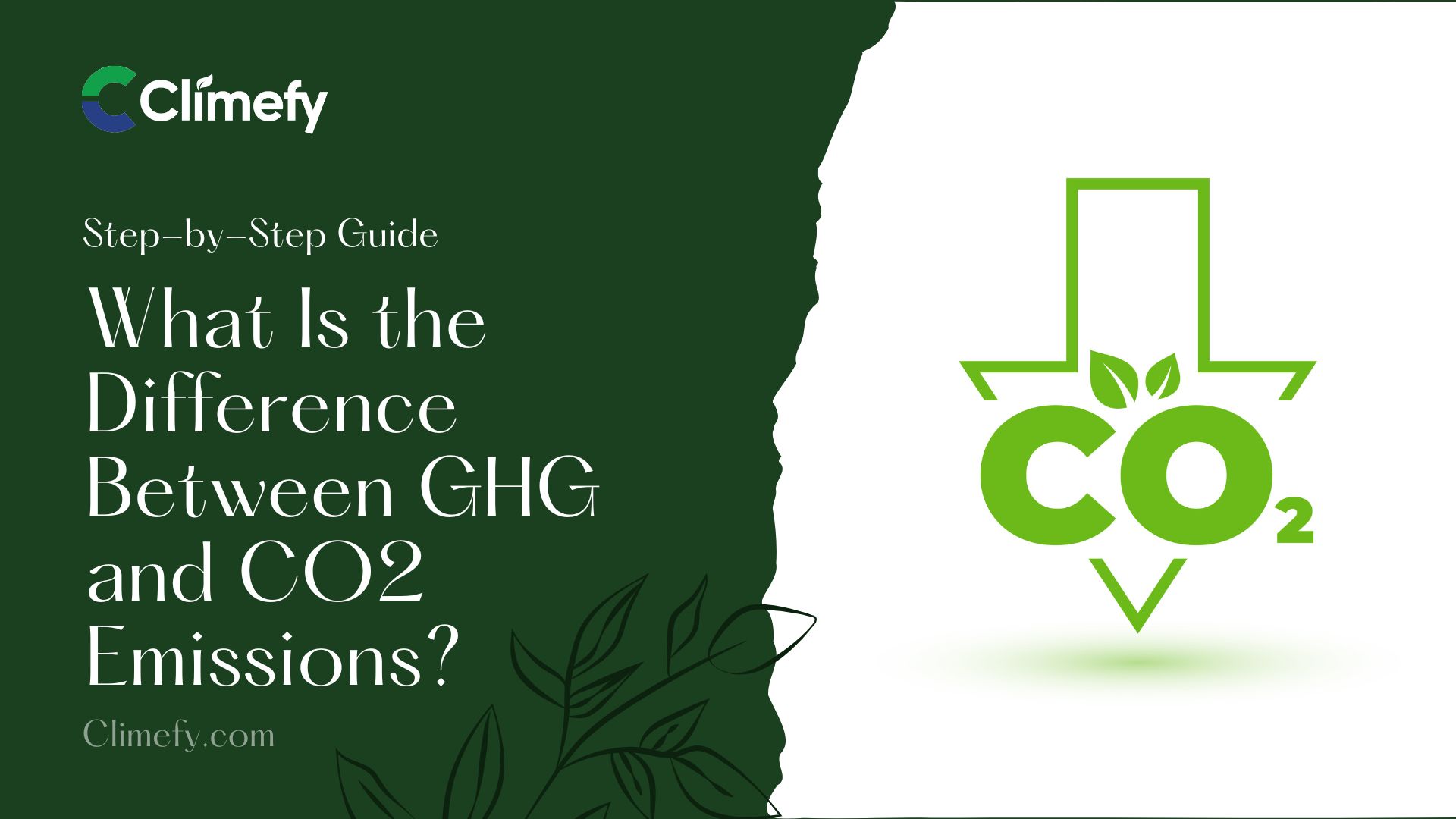

Understanding the distinction between GHG emissions and CO2 emissions is fundamental to grasping the science of climate change and formulating effective strategies for mitigation. While these terms are often used interchangeably, they represent different concepts in environmental science, with CO2 being a single component of the much larger and more complex group of Greenhouse Gases (GHGs). This ultimate guide will demystify these critical terms, explore their sources, impacts, and the frameworks used to manage them, providing a comprehensive resource for individuals and businesses aiming to make a tangible environmental impact.
In this guide, you will learn:
Read More:
![What Is the Difference Between GHG and CO2 Emissions? [Ultimate Guide] 1 What-Is-the-Difference-Between-GHG-&-CO2-Emissions](https://climefy.com/wp-content/uploads/2025/11/What-Is-the-Difference-Between-GHG-CO2-Emissions-1024x576.jpg)
The primary difference between GHG and CO2 emissions lies in their scope and definition. Carbon dioxide (CO2) is a specific, individual chemical compound, while Greenhouse Gases (GHGs) represent a broader category or a “basket” of multiple gases that have the ability to trap heat in the Earth’s atmosphere. In essence, CO2 is a subset of GHG emissions.
All CO2 emissions are a type of GHG emission, but not all GHG emissions are CO2. This is a critical distinction because the various GHGs have vastly different potencies and lifetimes in the atmosphere.
When we report on GHG emissions, we typically convert the impact of all non-CO2 gases into a standardized unit called carbon dioxide equivalents (CO2e), which allows for a consolidated and comparable measure of total climate impact based on their global warming potential.
This comprehensive approach is essential for accurate carbon accounting and for developing meaningful climate action strategies, such as those supported by the Climefy Verified Carbon Standard.
Key Established Facts:
Greenhouse Gases (GHGs) are gaseous components of the atmosphere that contribute to the greenhouse effect by absorbing and emitting radiant energy within the thermal infrared range. This natural process is vital for life on Earth, as it maintains a habitable planet temperature.
However, human activities have drastically increased the concentration of these gases, thickening the atmospheric blanket and leading to global warming and climate change.
These gases are characterized by their ability to absorb energy, their lifetime in the atmosphere, and their global warming potential (GWP). Managing these emissions is a core focus of modern environmental strategy, and tools like the carbon calculator for large organizations are designed to track this complex mix of gases.
The Intergovernmental Panel on Climate Change (IPCC) identifies several key greenhouse gases influenced by human activity, each with distinct properties and sources. The major GHGs covered under the Kyoto Protocol and subsequent international agreements are:
Global Warming Potential (GWP) of Key GHGs Over 100 Years:
| Greenhouse Gas | Chemical Formula | Global Warming Potential (GWP) | Major Anthropogenic Sources |
|---|---|---|---|
| Carbon Dioxide | CO2 | 1 (The Baseline) | Fossil fuel burning, deforestation, cement production. |
| Methane | CH4 | 27-30 | Fossil fuel extraction, livestock, landfills, rice cultivation. |
| Nitrous Oxide | N2O | 273 | Agricultural soil management, industrial processes, fuel combustion. |
| Sulfur Hexafluoride | SF6 | 24,300 | Electrical insulation, metal manufacturing. |
Carbon Dioxide (CO2) is a naturally occurring chemical compound composed of one carbon atom covalently double bonded to two oxygen atoms. It is a colorless, odorless gas that is integral to biological processes like photosynthesis and is a byproduct of respiration and combustion.
CO2’s significance in the climate crisis stems from its overwhelming volume in anthropogenic emissions and its long atmospheric lifetime. While individual molecules of other GHGs can trap more heat, the sheer quantity of CO2 released by human activities makes it the single most important driver of climate change.
A substantial portion of the CO2 emitted today will remain in the atmosphere for hundreds to thousands of years, creating a long-term commitment to climate change. Reducing CO2 emissions is therefore the cornerstone of any credible net zero journey for a company or nation.
Key Established Facts:
Since greenhouse gases vary tremendously in their ability to absorb heat and how long they persist in the atmosphere, a standardized metric is essential for comparison and policy-making. This metric is Carbon Dioxide Equivalent (CO2e).
CO2e converts the mass of any greenhouse gas into the equivalent mass of CO2 that would cause the same amount of radiative forcing, or warming, over a given time period (usually 100 years). It does this by multiplying the mass of the gas by its Global Warming Potential (GWP).
For businesses and individuals using a carbon calculator for small & medium companies, the final footprint is almost always reported in tonnes of CO2e, providing a unified view of their total climate impact.
Calculation Example:
Understanding the sources of emissions is the first step toward managing them. Emissions are generated from nearly every sector of the modern global economy, and they can be categorized to better target reduction strategies. Comprehensive carbon accounting is the process used to quantify these sources, which is a specialty of Climefy’s ESG Consultancy.
Human-caused GHG emissions originate from a wide array of activities. The following list breaks down the major contributing sectors globally:
Carbon accounting is the systematic process of measuring, tracking, and reporting the amount of greenhouse gases an organization, individual, or product is responsible for emitting. It is the foundation for any serious climate action plan.
To bring structure and standardization to this process, the World Resources Institute (WRI) and the World Business Council for Sustainable Development (WBCSD) developed the Greenhouse Gas Protocol, which categorizes emissions into three “scopes.” Understanding these scopes is critical for using tools like the carbon calculator for individuals or corporate versions effectively.
The GHG Protocol Corporate Standard classifies a company’s GHG emissions into three scopes to ensure no double-counting and to clarify responsibility.
Scope 1 emissions are direct greenhouse gas emissions that occur from sources that are owned or controlled by the reporting organization. They are the most straightforward to quantify and manage.
Examples of Scope 1 Emissions:
Scope 2 emissions are indirect GHG emissions associated with the generation of purchased electricity, steam, heating, or cooling that is consumed by the reporting organization. While the physical emissions occur at the utility facility, they are a result of the organization’s energy consumption.
Examples of Scope 2 Emissions:
Scope 3 emissions are all other indirect emissions that occur in a company’s value chain. They are often the largest and most complex category to measure, but they typically represent the greatest opportunity for impact reduction. For many companies, Scope 3 can account for more than 70% of their total carbon footprint.
Examples of Scope 3 Emissions (Upstream & Downstream):
Mitigating climate change requires a two-pronged approach: reducing the amount of GHGs we release into the atmosphere (emissions reduction) and removing existing GHGs from the atmosphere (carbon removal). A comprehensive strategy often involves a combination of the following actions, which can be guided by expert partners like an eco-friendly partner.
Emissions reduction focuses on preventing GHGs from being released in the first place. This involves transitioning to cleaner technologies and improving efficiency.
Established Reduction Strategies:
Carbon Dioxide Removal (CDR) encompasses technologies and approaches that remove CO2 from the atmosphere and durably store it. While emissions reduction is the priority, CDR is increasingly seen as necessary to counterbalance hard-to-abate emissions.
Key Carbon Removal Methods:
Carbon offsetting is a mechanism that allows an entity to compensate for its emissions by financing an equivalent reduction or removal of GHG emissions elsewhere. When you purchase a carbon offset credit, you are funding a project that prevents, reduces, or removes GHGs from the atmosphere.
One carbon credit typically represents one metric tonne of CO2e reduced or removed. It is crucial that these projects are real, additional (meaning the reduction would not have occurred without the offset funding), permanent, and verified to prevent greenwashing. Platforms like the Climefy Marketplace are dedicated to connecting buyers with high-quality, verified projects.
Carbon offset projects are diverse and can be grouped into several categories based on their methodology.
Tackling the climate crisis requires action at all levels, from individual lifestyle changes to comprehensive corporate sustainability strategies. The journey begins with measurement and is followed by targeted action.
For organizations committed to sustainability, a clear, actionable pathway is essential.
Individual actions, when multiplied by millions, create a significant collective impact.
Actionable Steps for Individuals:
Not necessarily. While CO2 is the most significant driver of climate change due to its massive volume and long lifetime, other gases like SF6 have a much higher global warming potential per molecule. “Worst” depends on the metric. CO2 is the most problematic due to its scale, but methane is particularly dangerous in the short term due to its high potency. A comprehensive climate strategy must address all major GHGs.
We focus on CO2 because it is the primary lever for long-term climate stability. Its abundance and longevity mean that cumulative CO2 emissions are the dominant factor determining global mean surface warming. Reducing CO2 emissions is fundamental to stopping the long-term increase in global temperatures. Simultaneously, reducing short-lived climate pollutants like methane can provide faster benefits for slowing near-term warming.
Carbon Neutral typically means balancing the amount of carbon released with an equivalent amount sequestered or offset. It often focuses only on CO2 and can be achieved primarily through offsetting. Net Zero is a more comprehensive and ambitious target. It requires deep reductions across all GHG emissions (Scopes 1, 2, and 3) as a priority, and any remaining residual emissions are balanced with an equivalent amount of carbon removal from the atmosphere (not just avoidance/reduction offsets). Climefy’s Net Zero Journey service helps businesses navigate this complex transition.
No, the quality of carbon offsets varies dramatically. High-quality offsets are defined by robust verification standards that ensure the projects are real, additional, permanent, independently verified, and have no negative social or environmental side effects. It is crucial to purchase offsets from reputable registries and standards, such as the Climefy Verified Carbon Standard, to ensure environmental integrity.
Look for projects certified under recognized standards that require third-party validation and verification. Check if the project is listed on a public registry that tracks credit issuance and retirement to prevent double-counting. Transparency in project documentation and a clear demonstration of “additionality” are key indicators of legitimacy. Educating yourself through resources like the Climefy Sustainability Academy can also provide the knowledge to make informed decisions.